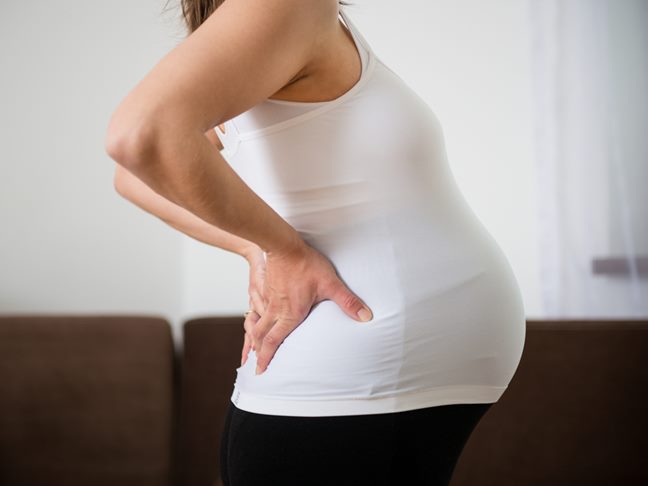Pregnancy and Back Pain: What You Can Do To Help
By Tyler Guymon, DPT
AZOPT Physical Therapist
I am very blessed to be the father of four beautiful children. But, as most people know, I would not have accomplished this great achievement without my wonderful wife. Confidently I will say that while my wife would not change anything about our kids or what they have added to our family, she would happily change how she felt during the nine months prior to each of their births.
Unfortunately, 50 to 70 percent of pregnant women experience back pain throughout their pregnancy. While the reason for back pain varies from person to person, the majority of back pain concerns can be traced to one or more of the following factors:
-
Increases in hormones
-
Change’s to the body’s center of gravity
-
Weight gain
-
Poor posture
-
Added stress
Over the last 40 years, the average age of women when they conceive their first child has risen from 21.4 to 25 years of age. Furthermore, with women juggling the demands of pursuing a higher education and a competitive workforce, more and more women are conceiving their first child after the age of 35. As a result, many women becoming pregnant are less physically active in their daily lives. This decreased activity, along with the increasing national prevalence of a sedentary lifestyle, leaves an alarming number of women less prepared for the strenuous journey of carrying and delivering a baby.
You may be surprised to learn that the previously mentioned factors that cause back pain can be address by a physical therapist through a personalized program. Through a detailed evaluation and a review of systems, a physical therapist will develop a plan of care that addresses:
-
Back pain
-
Decreased flexibility
-
Muscle weakness
-
Poor posture
-
Nerve irritation/involvement
-
Problems with joint alignment
Although it would be difficult to prescribe a generic exercise/stretching program that is appropriate for every woman, here are a few exercises that I feel would benefit all pregnant woman experiencing back pain:
Wall Push-Ups
Start your pregnancy exercises with wall push-ups, which work the pectoral muscles in the front of your chest and the triceps muscles in the back of your upper arm.
- Standing and facing a wall, lean forward and place your hands on the wall at shoulder height, slightly wider than shoulder-width apart.
- Keep your knees comfortably apart.
- Slowly bend your elbows and lower your chest until your chin reaches the wall.
- Remember to keep your back straight.
- Then return to the starting position.
- Gradually work up to 15 repetitions.
Squats With a Fitness Ball
Squatting during labor — even for short amounts of time — help open your pelvic outlet and allows more room for your baby to descend. Practicing squats now will make it easier to squat during labor. Try squats with a fitness ball.
- Stand up straight with a fitness ball behind your back and against the wall, your feet about shoulder-width apart.
- Be sure to have feet far enough from the wall that your knees do not pass the toes at the bottom of your squat.
- Slide down the wall until your knees reach a 90-degree angle, being careful to keep your heels flat on the floor.
- Maintain upright posture – do not lean back over ball or bend forward as you descend.
- If you can’t bend your knees to a 90-degree angle, simply go as low as you can — then return to the starting position.
- Gradually work up to 10 repetitions.
Leg lifts
To strengthen your back and abdominal muscles, try leg lifts.
- Start on your hands and knees, keeping your arms straight and your hands directly beneath your shoulders.
- Lift your right knee, straightening your leg behind you — ending with the raised leg parallel to the floor.
- Maintain level hips – do not roll to the side, and be sure to tighten
your stomach. - Repeat on the other side.
- Gradually work up to 10 repetitions on both sides.
Side planks
The side plank challenges your stability and works the muscles along the side of your body.
- Lie on your left side and raise yourself onto your left forearm.
- Place your left shoulder directly above your left elbow, keeping your shoulders, hips and knees in alignment.
- Again, do not roll to the side or lean back/forward
- Rest your right arm along the side of your body.
- Hold for several seconds, and then lower yourself to the floor.
- Gradually work up to 10 repetitions.
- Repeat on the other side.
Step ups
To do a step-up, you’ll need a small step stool — or you can stand in front of the stairs.
- Position yourself near a wall or railing for extra balance or support, if needed.
- Pushing primarily through your lead foot, lift your body up onto the step.
- Then step backward to the starting position.
- Alternate your lead foot each time you step up.
- Remember to keep your back straight and plant your foot entirely on the step.
- Do as many repetitions as you can, depending on your fitness level.
- Stop when you’re fatigued or your form begins to suffer.
If you are new to exercise and fitness, or just don’t know what to do, please first check with your doctor or a licensed physical therapist prior to starting an exercise program to reduce the risk of injury or increased pain.
Call AZOPT at (623) 242-6908 to schedule an evaluation today if you feel you can benefit from a licensed physical therapist through your pregnancy.












